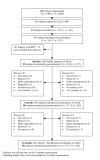The effects of a controlled worksite environmental intervention on determinants of dietary behavior and self-reported fruit, vegetable and fat intake
- PMID: 17044935
- PMCID: PMC1626462
- DOI: 10.1186/1471-2458-6-253
The effects of a controlled worksite environmental intervention on determinants of dietary behavior and self-reported fruit, vegetable and fat intake
Abstract
Background: Eating patterns in Western industrialized countries are characterized by a high energy intake and an overconsumption of (saturated) fat, cholesterol, sugar and salt. Many chronic diseases are associated with unhealthy eating patterns. On the other hand, a healthy diet (low saturated fat intake and high fruit and vegetable intake) has been found important in the prevention of health problems, such as cancer and cardio-vascular disease (CVD). The worksite seems an ideal intervention setting to influence dietary behavior. The purpose of this study is to present the effects of a worksite environmental intervention on fruit, vegetable and fat intake and determinants of behavior.
Methods: A controlled trial that included two different governmental companies (n = 515): one intervention and one control company. Outcome measurements (short-fat list and fruit and vegetable questionnaire) took place at baseline and 3 and 12 months after baseline. The relatively modest environmental intervention consisted of product information to facilitate healthier food choices (i.e., the caloric (kcal) value of foods in groups of products was translated into the number of minutes to perform a certain (occupational) activity to burn these calories).
Results: Significant changes in psychosocial determinants of dietary behavior were found; subjects at the intervention worksite perceived more social support from their colleagues in eating less fat. But also counter intuitive effects were found: at 12 months the attitude and self-efficacy towards eating less fat became less positive in the intervention group. No effects were found on self-reported fat, fruit and vegetable intake.
Conclusion: This environmental intervention was modestly effective in changing behavioral determinant towards eating less fat (social support, self-efficacy and attitude), but ineffective in positively changing actual fat, fruit and vegetable intake of office workers.
Figures
References
-
- U.S. Department of Health and Human Services Physical Activity and Health: A Report of the Surgeon General. Atlanta, GA: US Department of Health Human Services, Centers for Disease Control and Prevention, National Center for Chronic Disease Prevention and Health Promotion. 1996.
-
- Blair S, Connelly J. How much physical activity should we do? The case for moderate amount and intensities of physical activity. RQES. 1996;67:193–205. - PubMed
-
- Pate R, Pratt M, Blair S, Haskell W, Macera C, Bouchard C, Buchner D, Ettinger W, Heath G, King A. Physical activity and public health: A recommendation from the centers for disease control and prevention and the American College of Sports Medicine. JAMA. 1995;273:402–407. doi: 10.1001/jama.273.5.402. - DOI - PubMed
-
- WHO Regional office for Europe Healthy Nutrition. Preventing nutrition related diseases in Europe. WHO regional publications 24. 1988. Braeckman L, Maes L, Bellemans M, Vanderhaegen M, De Maeyer A, De Bacquer D, and De Backer G, Worker participation in a nutrition education programme. Arch Public Health. 1998;56:275–289.
-
- Hulshof K, Ocke M, van Rossum C, Buurma-Rethans E, Brants H, Drijvers J. Results of the Dutch Food Survey 2003 (article in Dutch) RIVM-rapport nr 350030002. 2004.
Publication types
MeSH terms
Substances
LinkOut - more resources
Full Text Sources
Medical


